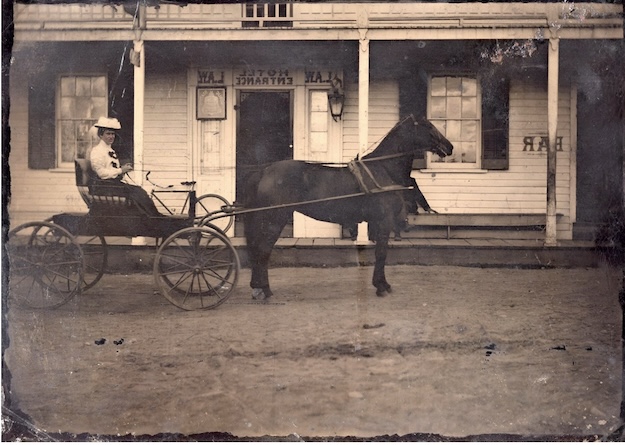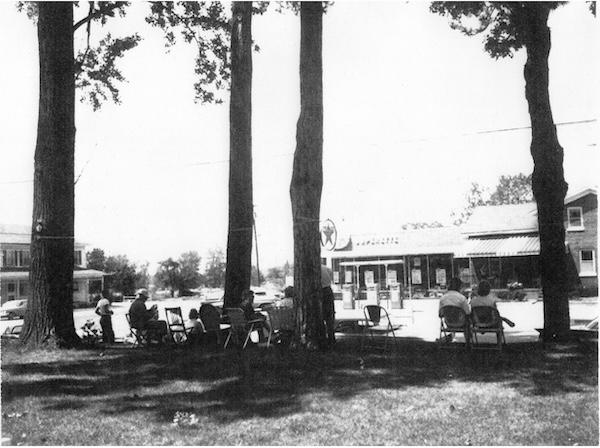Gaines historian reflects on county bicentennial with many enduring local landmarks
‘Continuity doesn’t mean that no change occurs, but that what does change remains recognizable and connected to the past.’ – Adrienne Kirby

A photo from the early 1900s, showing the front of what is now the Tavern on the Ridge, the former Village Inn.
By Adrienne Kirby, Town of Gaines Historian
GAINES – The Bicentennial of Orleans County is a singular point in time to reflect on our roots. As historian, it is part and parcel of my job description.
Occasionally, I am asked to provide a letter of support for historical endeavors in Gaines. Several years ago, the Cobblestone Society asked for a letter to support their efforts to place the hamlet of Childs on the National Historic Register. As I thought about the importance and significance of Childs and of how I would express that to someone who had never seen it, I realized that what I had written was a bit of an “Ode to Childs” in prose.
In the spirit of the County Legislature, which encouraged the citizens of Orleans County to “commemorate the worthwhile endeavors of their predecessors and look forward to the future of this fine county with optimism,” in their Proclamation for the Bicentennial, I present my reflection on Childs, NY.
Our two hundred year old home sits on a rise that slightly elevates it above most of the other buildings in Childs. One of my favorite aspects of our house is the view from my son’s second story bedroom window at night. From there, I can look over the rooftops of my neighbors to the east and see the heart of Childs.
From this angle, the Tavern on the Ridge is barely visible, largely in shadow. The traffic light indicates the crossroads hidden by the silhouettes of houses crowded up against the southwest corner. A portion of Crosby’s signage glows, adding further illumination to the Cobblestone Church, its bell tower a stunning stark white against a black evening sky. This scene is almost magical on a snowy winter’s night; it is so still and peaceful.
A notable aspect of Childs is its continuity. Continuity doesn’t mean that no change occurs, but that what does change remains recognizable and connected to the past. Architecturally speaking, some buildings have been repurposed from their original intent. Others have had some minor exterior cosmetic changes made over the last sixty years in the name of energy efficiency or ease of maintenance. But by and large, these buildings would be easily recognized by their former inhabitants. The convenience store building, a mere fifteen years old, can also lay claim to continuing Child’s history; there has almost always been a general store on that corner, selling food and sundry goods.

A photo from 1964 shows spectators gathered across the road from the H&A Superette to view the addition of the restored tower to the Cobblestone Church.
The buildings in Childs take center stage, and yet there are trees, too, that serve as landmarks and contribute to the sense of continuity here. Driving in from the east, the lone pine in the front yard of the Visitor’s Center signals one’s approach to Childs long before the road sign does.
Coming from the south, a beautiful sycamore just north of the intersection, nearly three times taller than the corner store, crowns the horizon. The oversize leaves and fragrant blossoms of the catalpa tree at the Vagg house add to the sense of place.
These particular trees and others, have been here nearly a hundred years or more. I know of an instance in which a neighbor successfully negotiated with the town to prevent an old maple from being cut down. The trees are as much a part of Child’s heritage as its buildings.
Two hundred years ago, most of Child’s citizens were farmers. Agriculture remains a primary industry in the Town of Gaines. Almost every backyard of the some dozen families of this hamlet looks out onto a field. In 1890, these fields probably produced beans. In the 1950s, there were surely tomatoes growing. Now, we tend to see wheat or soybeans.
Agriculture has yet another impact here. Unlike many other livelihoods and professions now, farmers don’t move every few years. Because they are dependent upon the land, they understand the value of a particular place. Farmers helped found the Cobblestone Society in order to save the cobblestone church, as well as the schoolhouse. They continue to be significant contributors to large scale community projects.
The National Register of Historic Places highlights what is unique and worth preserving for a national audience. A successful application from the Cobblestone Society to place the hamlet of Childs on the Register will affirm and make known to the whole country what we who live here have long known and appreciated.
The Cobblestone Church, Ward House and Schoolhouse have been designated National Historic Landmarks for several decades, the only buildings in Orleans County to have that honor. But in March of this year, all of Childs was placed on the National Register of Historic Places, giving our bit of Western New York a well-deserved national spotlight, highlighting how the past and the present can live side by side. It is a source of pride to those of us, who, in the words of the Legislature, “acknowledge the advantage of living here.”







































































